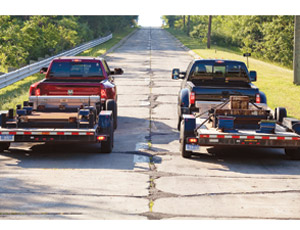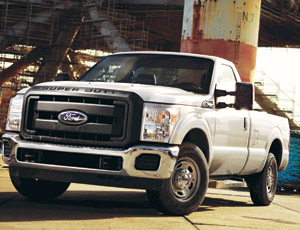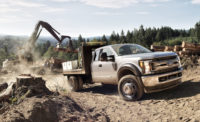Over the past year, ENR has tested and reviewed the all-new 2010 Ram Heavy Duty, the 2011 Ford Super Duty and the 2011 Chevrolet Silverado HD/GMC Sierra HD, but our friends at PickupTrucks.com have taken evaluating these workhorses to another level.


Dubbed the 2010 Heavy-Duty Shoot-Out, this pinnacle of comparison tests recently subjected these beasts of burden to such abuses as full-throttle hill climbs with 12,000 lb in tow, quarter-mile drag races, severe braking exercises and everything in between. Winners were determined based on subjective evaluations, instrumented testing and fuel economy.
“It’s a set of very rigorous and repeatable tests,” explains Mike Levine, the website’s editor, who says this is his third time pitting heavy-duty pickups against each other. HD pickups are classified as three-quarter tons and up; full-size pickups that remain in the half-ton class and even smaller pickups were outside of the scope of the “shoot-out.”
Fuel economy, ride and handling, comfort and interior features were evaluated primarily on public roads. Consumption of diesel-exhaust fluid (DEF), which is a new requirement on most 2010 diesels, also was tracked. Nine four-wheel-drive crew-cab trucks were broken down into three classes: three-quarter-ton gasoline, three-quarter-ton diesel and one-ton diesel. PickupTrucks.com also brought in third-party engineering consultant Ricardo Inc. to instrument and monitor the testing to ensure objectivity.
The Trucks
The three-quarter-ton gas lineup consisted of a 2011 Chevrolet Silverado 2500HD with a 6.0-liter V-8 ($45,699), a 2011 Ford F-250 Super Duty motivated by a 6.2-liter V-8 ($45,245), and a 2010 Ram 2500 Heavy Duty fitted with a 5.7-liter HEMI ($44,365).
The three-quarter-ton diesels included a 2011 Silverado 2500HD fitted with a 6.6-liter Duramax V-8 ($60,619), a 2011 F-250 sporting Ford’s 6.7-liter Power Stroke V-8 ($61,805), and a 2010 Ram 2500 equipped with a 6.7-liter Cummins inline six ($52,170). The same diesel engines powered the one-ton trucks, which included a 2011 GMC Sierra 3500HD ($60,935), a 2011 Ford F-350 ($62,585) and a 2010 Ram 3500 ($58,160).
General Motors’ Milford proving grounds near Detroit hosted towing and braking exercises. Hooked to loaded trailers, each truck was subjected to full-throttle runs up 7% and 16% grades and judged on speed and transmission response. Exhaust braking was monitored on downgrades. Sixty-to-zero mph stopping distances were measured, both unloaded and with one ton of ballast. Performance testing was conducted at the Milan Dragway in Milan, Mich.
The Results
Light-duty, half-ton pickups, the payload and tow ratings of which have risen dramatically over the past several years, have started to encroach on heavy-duty territory. “But that doesn’t mean heavy-duty trucks are sitting still,” says Levine. The shoot-out proved that competition is just as fierce within the HD class.
On the drag strip, with and without a laden trailer, the Ram used HEMI power to take the lead in zero-to-60 mph testing, while the Duramax cleaned house in the diesel quarter-mile. When tackling the 7% uphill grade, Ford used its 6.2-liter V-8 gasser to haul a 10,000-lb trailer the quickest, while the Ram’s slow-shifting, five-speed transmission relegated it to third place. The three-quarter-ton Chevrolet muscled ahead with its Duramax; the Ford F-350 used its Power Stroke to outrun the other one-tons. Challenged by the 16% grade, Ford’s gas V-8 again proved dominant. The three-quarter-ton diesel set was led by Chevrolet, and that same Duramax grunt helped the GMC 3500HD climb the steeper hill faster than its one-ton challengers. That monstrous truck also stopped shorter than the competitors, and as with the Duramax-powered three-quarter-ton Chevy, earned best-in-class fuel economy when not towing. Hooked up to a trailer, the Super Duty proved more efficient regardless of engine.
With testing complete, three winners emerged. Ford took best three-quarter-ton gas with the F-250 Super Duty. But GM swept the diesel category with its best three-quarter-ton Silverado 2500HD and best one-ton Sierra 3500 HD Denali.
The Fleet Pick
Though the shoot-out focused purely on judging the trucks and their performance, we wanted to know which heavy-duty pickup the orchestrator of the event would recommend for the jobsite. Levine says he favors the GM trucks for their excellent total integration of vehicle, but he claims the aging Duramax engine has been squeezed for all the horses it can muster. Conversely, Ford’s clean-sheet Power Stroke, though brand-new, already has been reprogrammed for added grunt (400hp/800 lb-ft of torque compared to the initial rating of 390 hp/735 lb-ft).
“These are tremendous trucks,” Levine says of Ford’s heavies, “especially if you are mixing pickups and chassis cabs.” Backed by a larger service network, they offer a solid front axle that can withstand the rigors of construction. Levine recommends Ford for owners of aging Rams and those building new fleets. However, for existing GM and Ford owners, he advises sticking with the brand you know.
In the future, these beastly pickups will become increasingly capable, and a new SAE standard will effectively drop the ratings for half-tons when it takes effect in 2013, notes Levine. A long-term wild card is the federal government’s planned fuel-economy standards for large trucks. Heavy-duty pickups, unregulated today, fall into this category. “The question is how much is it going to cost,” Levine says, “and that’s still an unknown. But you can bet that, independent of inflation, it is going to add at least several thousands of dollars to the cost of these trucks.”


Post a comment to this article
Report Abusive Comment